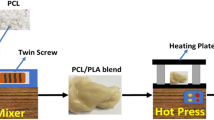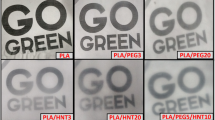Abstract
Thermodynamically immiscible poly(lactic acid) (PLA) and poly(ε-caprolactone) (PCL) were blended and solution-cast by adding the 3% compatibilizer (tributyl citrate, TBC) of the PCL weight. In the PLA/PCL composition range of 99/1–95/5 wt%, mechanical properties of the PLA/PCL films with TBC were always superior to those of the films without TBC. The tensile strength of 42.9 ± 3.5 MPa and the elongation at break of 10.3 ± 2.7% were observed for the 93/7 PLA/PCL films without TBC, indicating that PCL addition is effective for strength and ductility. However, the tensile strength of 54.1 ± 3.4 MPa and the elongation at break of 8.8 ± 1.8% were found for the 95/5 PLA/PCL with TBC, indicating that the effect of co-addition of PCL and TBC on mechanical properties of the films is more pronounced. No cytotoxicity was observed for the PLA/PCL films regardless of TBC addition.






Similar content being viewed by others
References
Sun H, Xiao A, Yu B, Bhat G, Zhu F. Effect of PCL and compatibilizer on the tensile and barrier properties of PLA/PCL films. Polym Korea. 2017;41:181.
Urquijo J, Guerrica-Echevarria G, Eguizabal JL. Melt processed PLA/PCL blends: effect of processing method on phase structure, morphology, and mechanical properties. J Appl Polym Sci. 2015;132:42641.
Cohn D, Salomon AH. Designing biodegradable multiblock PCL/PLA thermoplastic elastomers. Biomaterials. 2005;26:2297.
Malinowski R. Mechanical properties of PLA/PCL blends crosslinked by electron beam and TAIC additive. Chem Phys Lett. 2016;662:91.
Martin O, Averous L. Poly(lactic acid): plasticization and properties of biodegradable multiphase systems. Polym. 2001;42:6209.
Seol B, Shin J, Oh G, Lee DY, Lee M. Characteristics of PU/PEG hybrid scaffolds prepared by electrospinning. J Biomed Eng Res. 2017;38:248.
Son S, Choi J, Cho H, Kang D, Lee DY, Kim J, Jang J. Synthesis and characterization of porous poly(ε-caprolactone)/silica nanocomposites. Polym Korea. 2015;39:323.
Kim Y, Son S, Chun C, Kim J, Lee DY, Choi HJ, Kim T. Effect of PEG addition on pore morphology and biocompatibility of PLLA scaffolds prepared by freeze drying. Biomed Eng Lett. 2016;6:287.
Jung Y, Kim SJ, Kim KJ, Lee DY. Characteristics of ionic polymer–metal composite with chemically-doped TiO2 particles. Smart Mater Struct. 2011;20:124004.
Chun C, Lee DY, Kim J, Kwon M, Kim Y, Kim S. Effect of molecular weight of hyaluronic acid on viscoelastic and particle texturing feel properties of HA dermal biphasic fillers. Biomater Res. 2016;20:275.
Kim J, Kim BS, Jeong HS, Heo YK, Shin S, Lee J, Shim YH, Lee DY. Effect of surface-treatments on flexibility and guided bone regeneration of titanium barrier membrane. J Korean Cryst Growth Cryst Technol. 2015;25:98.
Kim JT, Lee DY, Kim T, Lee M, Cho N. Biocompatibility of hyaluronic acid hydrogel prepared by porous hyaluronic acid microbead. Met Mater Int. 2014;20:555.
Kim J, Lee DY, Kim E, Jang J, Cho N. Tissue response to implant of hyaluronic acid hydrogel prepared by microbeads. Tissue Eng Regen Med. 2014;11:32.
Acknowledgements
KJK and TH would like to acknowledge this material is based upon work supported in part by the National Science Foundation under Grant No. IIA-1301726.
Author information
Authors and Affiliations
Corresponding author
Ethics declarations
Conflict of interest
The authors declares there is no conflict of interest.
Ethical approval
This article does not contain any studies with human participants or animals performed by any of the authors.
Rights and permissions
About this article
Cite this article
Jeong, H., Rho, J., Shin, JY. et al. Mechanical properties and cytotoxicity of PLA/PCL films. Biomed. Eng. Lett. 8, 267–272 (2018). https://doi.org/10.1007/s13534-018-0065-4
Received:
Revised:
Accepted:
Published:
Issue Date:
DOI: https://doi.org/10.1007/s13534-018-0065-4




